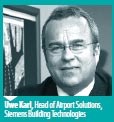Heightened aviation security since the 9/11 attacks and subsequent terrorist threats has brought along increased awareness, for danger can be detected or deterred before brought into the air.
As new airports continue to be constructed and existing ones upgraded, newer technologies like HD video surveillance, video content analysis and management software are gradually adopted to enhance the security and safety of complex airport and aviation operations. Security management of the entire premises is, thus, increasingly highlighted. One of the top challenges faced by system integrators today is assimilating new technologies and products into existing systems, as old and new systems often have trouble communicating with one another. However, should an airport project adopt technologies based on an open platform, integration would be much smoother, with extra cost minimized and existing investment extended.
Heightened aviation security since the 9/11 attacks and subsequent terrorist threats has brought along increased awareness, for danger can be detected or deterred before brought into the air.
As new airports continue to be constructed and existing ones upgraded, newer technologies like HD video surveillance, video content analysis and management software are gradually adopted to enhance the security and safety of complex airport and aviation operations. Security management of the entire premises is, thus, increasingly highlighted. One of the top challenges faced by system integrators today is assimilating new technologies and products into existing systems, as old and new systems often have trouble communicating with one another. However, should an airport project adopt technologies based on an open platform, integration would be much smoother, with extra cost minimized and existing investment extended.

It is common to find restaurants, retail shops, cafes — and even hotels, spa centers and casinos — in today's airports. “As airports provide a global transportation network among cities, they are important hubs and have considerable regional economic significance, giving the cities they serve great commercial advantages over those that do not have them,” said Uwe Karl, Head of Airport Solutions, Siemens Building Technologies. “Airports will undoubtedly continue to grow in number, and existing airports will continue to grow in size in order to satisfy the increasing demand for mobility. The systems employed to protect them, therefore, need to accommodate such growth, with a smooth migration path to allow systems to expand easily.”
Newer, Bigger, Better
 The mature markets in North America and Western Europe see a continuation of security upgrades. “The sales outlook is promising as threat has not lessened,” said Mark Wilson, VP of Marketing, Infinova. “The biggest need requested by airports in North America is HD video surveillance.”
The mature markets in North America and Western Europe see a continuation of security upgrades. “The sales outlook is promising as threat has not lessened,” said Mark Wilson, VP of Marketing, Infinova. “The biggest need requested by airports in North America is HD video surveillance.”
The US market is continuing at a good pace, fueled by the events of 9/11 and carried through up until the Obama administration, said Mark Moscinski, VP of Safety and Security, System Development Integration. “Federal stimulus funding has also kicked in for many airport security projects with design phases giving way to implementation projects; in fact, we seem to be only at a halfway point through the federal funds for the realization of our current projects.” In the last few years, large airports in Europe have had more difficulty with growth than smaller airports, and this trend will continue in the next five years, said Arjan Bouter, International Sales Manager at Nedap. “In Europe, large airports are looking for more flexible solutions to curb the impact of disruptions by extreme weather conditions and other disasters.”
Newer airports in the Middle East and Asia will also challenge the European ones, Bouter continued. “Obviously, this will have an effect on security management systems; new safety and security platforms will contribute to a lower TCO that improves the competitveness of European airports.”
this will have an effect on security management systems; new safety and security platforms will contribute to a lower TCO that improves the competitveness of European airports.”
New and upgrade projects in emerging markets, such as China, India, Southeast Asia, Eastern Europe, Russia and Latin America, see healthy growth in number. “We recently completed a project for 22 airports in India, in addition to other major projects in Easter Europe and the Middle East,” Wilson said. “For these projects, we used a combination of analog and HD cameras, and in many cases, they are taking advantage of the existing fiber optics.”
These regions are characterized by strong expansion. For instance, China has planned over the next five years 55 new airports to cover the expansion of traffic, Bouter added. “These regions will implement new security platforms, often based on open standards.” 
Many airports in these regions are also undergoing a “face-lift,” and usually for these projects, HD and megapixel technologies are sought after in conjunction with advanced software like video content analysis (VCA), said Aluisio Figueiredo, COO of Intelligent Security Systems. Overall, the physical security market for airports is expected to double by 2016, said Julian Harris, Research Analyst for Aerospace and Defense in North America, Frost & Sullivan. “Perimeter security is growing significantly due to technology innovation and the push to protect patron safety. We see fiber-optic fencing experience more growth than traditional fencing, as the former continues to be invested in.”
In video surveillance, Harris sees more IP surveillance installed at larger international airports, while smaller airports opt for analog technology with less integration of disparate security systems. “In terms of access control, fingerprint readers tend to be adopted by larger airports, while smaller airports stick to standard access control protocol, suggesting that larger airports are exploring more options.”
Biometrics will continue to play an increasingly crucial role, agreed Scott Mahnken, VP of Marketing, Bio-Key International. “Convenience and security are paramount in airports, and biometrics are virtually impossible to corrupt yet involve no cards, passwords or tangible assets. Documents may be forgotten, but we will always have our fingerprints or other biometric attributes.”